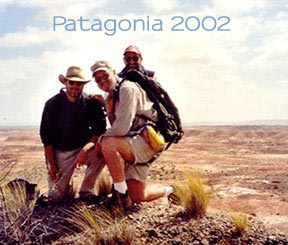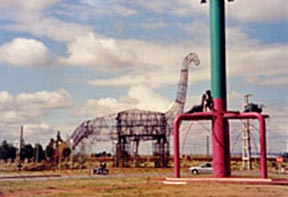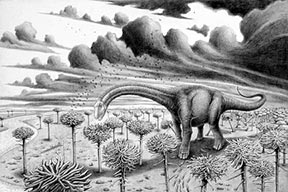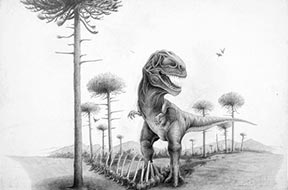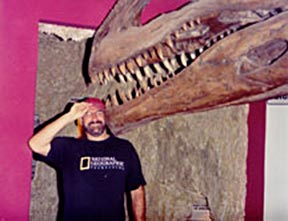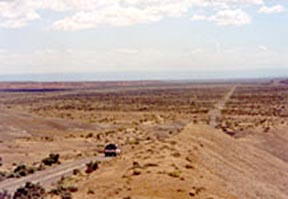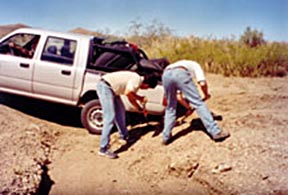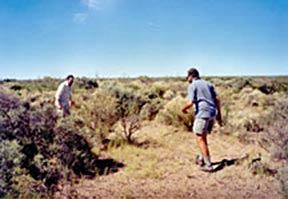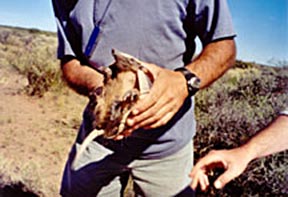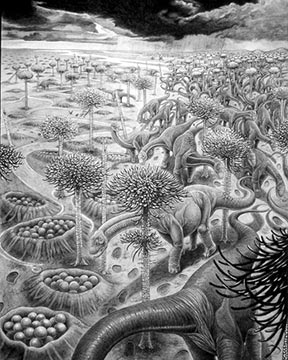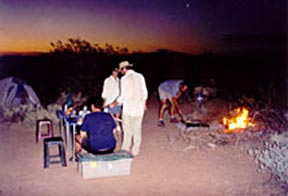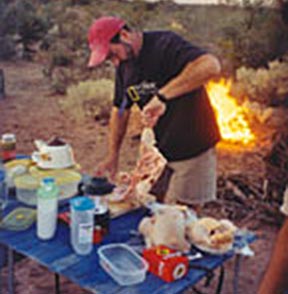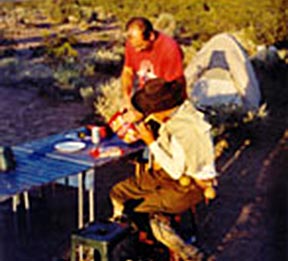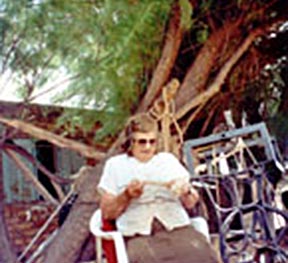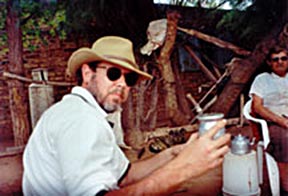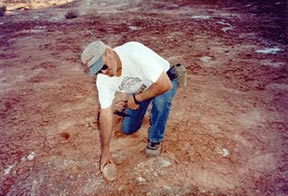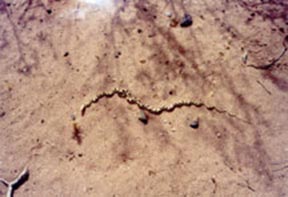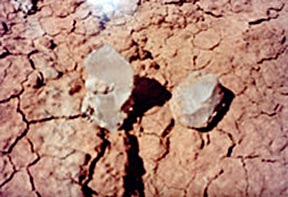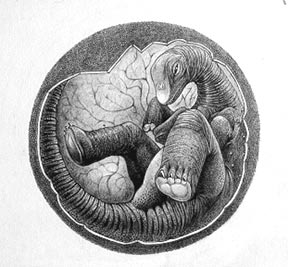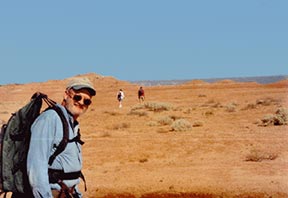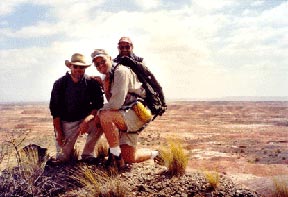Auca Mahuida, Patagonia 2002
The Search for the Lost Valley of Auca Mahuida by Art Ballard.
In February of 2002, I accompanied Dr. Lowell Dingus of Infoquest, Dr. Luis Chiappe, and Megan Walsh of the Natural History Museum of Los Angeles County, and Alberto Garrido, an Argentine doctoral candidate in geology, to the Auca Mahuida area of Patagonia. I chose the perhaps slightly misleading title for this report from a presentation I made to the Boy Scouts of Troop 491 in Montgomery, Texas, where I live. The “Lost Valley of Auca Mahuida” was not exactly lost, but we did in fact search for an access route into a remote and isolated valley in the Auca Mahuida area, south of where Lowell and Luis had earlier made a fabulous find of the largest sauropod nesting site in the world. The entire trip was a great adventure, but the search for the valley was especially exciting, especially for Lowell. More about that later.
Luis, Lowell, and our Argentine colleague Rodolfo Coria had dubbed the area of their dinosaur nesting site “Auca Mahuevo,” a play on words in Spanish, roughly meaning “look, more eggs!”. Lowell had told me on the phone that, just as in the title of his book with Luis, “Walking on Eggs”, there were places where the nests were so abundant, you literally could not avoid stepping on egg fragments. The trip was to be a great adventure, and resulted in more important finds which will shed more light on dinosaur development and behavior, and on the geology of the Patagonian Cretaceous.
Lowell and I had been friends and colleagues as undergraduates at UC Riverside’s excellent and rigorous geology department in the 70’s, and as graduate students there under Dr. Mike Woodburne in vertebrate paleontology. At the time of this expedition, I was a manager for a division of Halliburton in South America. Halliburton made a small donation to Infoquest in support of this and other Infoquest activities.
When I learned of Lowell and Infoquest’s activities in Patagonia, I shamelessly campaigned with Lowell for an invitation to join him and Luis on a field expedition in Patagonia. I had often flown over or driven through the area when visiting Halliburton operations in Neuquen, Rincon de los Sauces and Comodoro Rivadavia, and yearned to one day explore the incredible extent expanse of sedimentary outcrops that appeared to stretch endlessly to the horizon. Lowell graciously extended an invitation, with the understanding that I would not embarrass him and would pay my own expenses. I assured Lowell I had reformed many of my old habits from our college days, and I did pay my own expenses.
I flew from Houston to Buenos Aires, and met Lowell at a small hotel in the beautiful Recoleta area, where many small upscale hotels, boutiques and sidewalk cafes are located, as well as the cemetery with the tomb of Eva Peron. A few days later we boarded a plane for the small city of Neuquen. Luis was carrying a large package wrapped in dark plastic containing a mold of dinosaur limb elements. The mold had been prepared at the Los Angeles County Museum for Rodolfo Coria of the Municipal Museum in Plaza Huincul (Carmen Funes). The package had the approximate size and shape of a human body, so I thought it remarkable no Argentine official displayed any curiosity about it as we schlepped the package through the streets and airports of Buenos Aires and Neuquen!
In Neuquen we purchased supplies, rented two small pickup trucks, and set out for our first stop, Plaza Huincul, some 90 miles or so west of Neuquen. At Plaza Huincul, I was startled to see at the entrance to the city an enormous, life-size model of Argentinosaurus fashioned from steel rods. I have seen many sauropods in museums, but the dimensions of the Argentinosaurus are fantastic, perhaps appearing more so compared to the puny vehicles passing alongside. Arriving at the museum, we were met by Rodolfo and a doctoral candidate in geology, Alberto Garrido, who would accompany us to the field. The museum is a real gem, with a full-size display of the Giganotosaurus, as well as several enormous vertebrae and limb elements from the Argentinosaurus, and several other well-mounted smaller specimens. We spent a couple hours visiting with Rodolfo and photographing the museum, and then struck out for the field, wanting to find a camp before nightfall.
Driving to Auca Mahuida from Plaza Huincul, the terrain becomes progressively more arid, with badlands interspersed with scrublands. We turned off the asphalt road and onto a dirt-gravel road and headed north towards a large extinct Miocene volcano visible on the horizon from many miles distant. On the way, Lowell pointed out an outcrop in the badlands and told me that a distinctive layer near the top of a buff-colored hill marked the first transgression of the newly-opened Atlantic Ocean onto Patagonia. I was dying to get into the badlands and explore. These rocks contain the records of huge events in earth history. Both the Pacific and the Atlantic Ocean have covered the area at various times. The Pacific was blocked from transgressing over Patagonia by the uplift of the Andes, and the Atlantic lapped over the area more than once after it formed when South America and Africa drifted apart.
We had turned off a fairly good gravel road onto other, less maintained roads, and crossing a ravine, had the first experience with what turned out to be a major hobby during our trip; digging one or both of the pickups out of one predicament or another. We got a vehicle stuck at least once every day, sometimes in what appeared to be impossible situations, far from any possible help. I often marveled at Luis and Lowell’s determination and courage; they would go anywhere, sometimes take seemingly unreasonable risks, and sacrifice all comfort, but they were resolved to get where they needed to go to carry out their research. This area of Patagonia is fairly remote, and in previous seasons, they had been stuck in camp for days as rains turned the desert to impassable mud fields. I also questioned my own soundness of mind; after all, one of the vehicles was on my American Express card, and I had more than one occasion to wonder whether I would have to report to the rental agency that their truck was planted deep in the Patagonian wilderness! Assuming of course, that I made it back to civilization myself!
On a later trip to Mongolia in the far northwest Gobi with Luis and Lowell, I got another lesson in my companions’ scientific fervor. We found ourselves in a really sticky situation. We were low on gasoline and faced with either retracing our route to purchase gasoline for our Russian 4x4, or pressing on to the next small settlement and risk being stuck for days without gasoline in an impossibly primitive Mongolian village. I opined we should perhaps take the conservative option and go back. Luis and Lowell looked at me patiently, and Luis said with a broad grin, “Art, in this business, we take risks…!” Indeed. Later in the Mongolia trip we crossed the Altay Mountain Range hundreds of miles from any possible help with no spare tire and one field-repaired tire. Luis and Lowell reassured me, “No problem, we get another flat, we just rent some camels and ride out……”. No problem.
The Patagonian countryside we crossed reminded me a bit of my hometown in the high Mojave Desert in California; desert, but with abundant scrub brush. Luis pointed out a striking, intensely green, almost chartreuse, thorn bush nearly completely devoid of leaves. Luis told us the xeric bush produces nearly all its chlorophyll in the stems, as a strategy to reduce surface area and thereby, water loss. Luis is very knowledgeable of the local flora and fauna, especially birds, and his observations contributed hugely to my enjoyment of the trip. Both he and Lowell are accomplished scientists, but their enthusiasm for “the field” (i.e. the boondocks) is identical to a child’s infinite curiosity. One day, as we drove through the scrub brush on a desert track, Luis had spied something out the window, and said “Stop!”. He threw open the door, and he and Lowell ran into the brush, chasing a small critter into the brush. It was a very amusing scene to me, to see these two respected scientists gleefully pursuing what turned out to be a small Argentine armadillo, a tatu.
We found a beautiful campsite in the bush, not far from one of the outcrops with dinosaur nests. I could not contain my excitement, and Lowell, perhaps sensing I was near creating a commotion, invited me to walk the kilometer or so to see a dinosaur nest before we set up camp. Standing in front of a nest, with a beautifully preserved pair of dinosaur eggs nearby, and seeing several other nests all around me, I experienced a magic moment that most paleontologists live for; being transported back in time, and seeing in the mind’s eye the magnificent sauropods jostling for space as they dug with their hind feet the four or five-foot diameter depressions in the soft soil to receive their eggs. I had traveled a long way to see this, something truly extraordinary and rare in the world, a dinosaur nesting site with the eggs in place and intact.
We spent the next several days prospecting areas Luis and Lowell’s field teams had visited previously, and Lowell mapped and measured the stratigraphy and extent of the egg layers. The evenings were priceless, usually spent around a campfire, sipping an excellent Argentine cabernet, with the southern sky brilliant overhead. I always enjoy seeing the Clouds of Magellan and the Southern Cross when I am in those southern latitudes, but it was especially enjoyable with the absolutely clear Patagonian skies and agreeable company. It was an especial treat around the campfire to listen Luis and Lowell’s stories of Patagonian and Mongolian adventures, and speculations on dinosaur and bird evolution and paleontology.
We had brought food supplies which did not require refrigeration, such as canned veggies and pastas; for meat, we traveled to nearby ranches (estancias) to buy goat or chicken. On previous trips, Lowell and Luis had established a good relationship with a remarkable woman, Dona Dora, whose estancia was near the abandoned mining village of Auca Mahuida. When we visited, she was working at a loom, operated by a foot pedal, spinning wool into yarn. She greeted us warmly, and hurried off to put on a pot of water. Argentine tradition is to offer visitors mate (pronounced mah-tay), which is a mixture of herbs placed in a gourd with boiling water; the mate is passed around the group and sipped through a straw, periodically replenished with more hot water. We sipped our mate, and Luis negotiated the purchase of our meat. We had earlier enjoyed a visit on horseback to our campsite of one of Dona Dora’s ranch-hands, the gaucho Juan. Juan is typical of the Argentine gaucho, hard working, hard drinking and proud. The day he visited our camp, it was hot, around 100 degrees, and he was far from the estancia and far from any water source. His canteen contained only wine! I was fascinated by his typical gaucho dress, especially his boots, which looked more like a pair of leather socks, they had no soles, probably not much needed as gauchos spend most their day on horseback.
Lowell and Luis expected to have a visit by helicopter near the end of our stay in the field by one of Infoquest Foundation’s most generous donors, of a well-known family foundation who wishes to remain anonymous. She is herself a geologist who had spent several seasons working in the Hell Creek area of Montana, and wanted to see the egg layers herself. Lowell and Luis hoped take advantage of the helicopter to visit a large valley with wonderful exposure of Cretaceous outcrops which we could see in aerial photos, but they had not been able to find a road to get close enough to walk to it. We did manage, after a couple of days navigating some very bad trails around the margins of the valley, to find a road that took us to within a few miles. During our evening meal of barbecued goat, Lowell and I convinced Luis that we should spend our last day in the field prior to Infoquest’s sponsor’s arrival walking into and prospecting the mostly unexplored valley. I turned in that evening dreaming of new finds, perhaps a dinosaur, perhaps more eggs.
We struck out for the valley early the next morning, Lowell, Luis, Megan and I in the cab of the 4x4 truck, and Alberto volunteering to ride in the back. We followed the route Luis had plotted with the GPS on our previous explorations, and left the truck to walk the four miles or so to the valley. We trudged over several small rises, always expecting to see the valley from the top of the next one, on the way pausing to look at an unusual black-and-white snake. The snake arranged his body in almost acute angles, to appear identical to the many crooked black-and-white sticks lying on the desert floor, a beautiful example of adaptation for camouflage. Finally, clearing the top of a rise, the valley opened below us, a wonderful exposure of badlands, possibly containing never-before-seen fossils. We posed for a discovery photograph, congratulating each other, then dropped over the edge. Just below the ridge, there was a layer of sediment littered with clear crystals of what appeared to be selenite, a gypsum crystal, which marks the desiccation of the last remnants of the sea which had covered the area. Alberto remarked that the selenite layer was thicker than he had seen in other areas to the south, which indicated it had been deposited more toward the center of the Cretaceous sedimentary basin.
We divided up, agreeing to meet more or less in the center of the valley later, and I spent several hours prospecting alone not finding any fossils, but satisfied to be on the hunt in a beautiful and remote place. As I reached the top of a hill, I saw Lowell beckoning to me excitedly from across a ravine. I hiked over to him, and he said Luis had told him on the radio that he had found something. We hiked north, and found Luis and Megan on an outcrop littered with more dinosaur nests, unmistakable round patches of sediment darker than their surroundings, littered with dark green egg fragments. Luis was very pleased, since he had found yet another egg with evidence of an embryo, and the imprint of the embryo’s skin on the inner surface of the egg, visible with a hand-lens.
We had a long walk out, this time mostly uphill, and departed for our camp, pleased with our efforts for the day. Before we arrived at the vehicle, there was another adventure I referred to at the beginning of this chronicle that nearly caused me to title it "The Lost Geologist of Auca Mahuida", but since I had promised Lowell not to embarrass him, I will not elaborate.
We returned the following day to Neuquen to meet with Infoquest’s sponsor and her party. She treated us to dinner at her hotel, and we had an especially fine time sharing paleontology stories with her. I was very sorry I had to leave the next day for Buenos Aires to return to my job at Halliburton and would not be able to accompany the party back to the fossil beds in the helicopter, but we agreed to meet again in August 2002 in Ulan Bator Mongolia, which we did, and which is another story.
Epilog: Since our trip, Luis Chiappe returned to the area with a photographer from the National Geographic Society (see the March, 2003 issue). He found many of the best egg nests looted by fossil pirates. Eggs from Auca Mahuida have been offered for sale on Ebay. The fossil outcrops lie mostly within an oilfield operated by the Spanish oil company, Repsol. The access roads for the wells unfortunately make it accessible to those who plunder Argentina’s unique fossils. Although illegal under Argentine law, the authorities do not have enough resources to control the piracy. The directors Infoquest are searching for funds to help preserve this unique piece of Earth’s history.
Pics coming soon...

